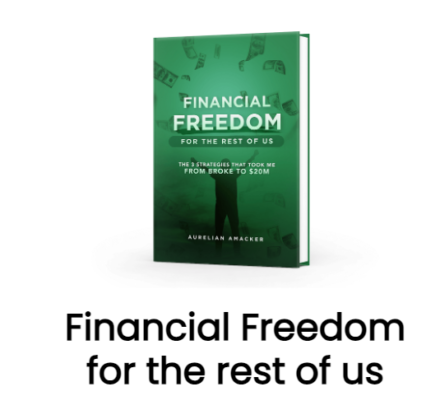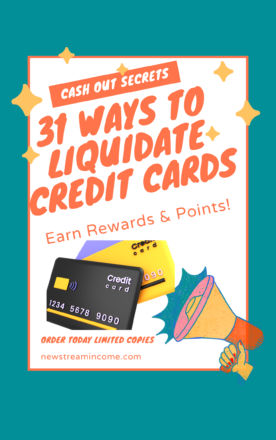Ever wish you could get a piece of the Amazon pie?
Corey Ganim banked $3.2 million in sales last year selling other people’s products on the e-commerce giant’s platform.
And he didn’t have to deal with the massive upfront costs and headaches of manufacturing his own products.
Corey got started in early 2019 and went full-time with his unique wholesale business model by mid-2020.
He’s since built a multi-million-dollar business buying brand-name inventory at wholesale prices and reselling it on Amazon at a profit.
In this episode, Corey shares his best tips and insights featured in his book, The 5 Pillars of Amazon Wholesale and his free Wholesale Challenge training.
Sponsors
Ladder – Get instantly approved for term life insurance—no doctors, no needles, no paperwork!
Indeed – Start hiring NOW with a $75 sponsored job credit to upgrade your job post!
Airbnb – Start an Airbnb business and earn money as an Airbnb Host!
Cantaloupe — Join the 30,000+ entrepreneurs who rely on Cantaloupe to run and grow their vending businesses!
The Appeal of Wholesale
There are plenty of ways to make money on Amazon—watching YouTube channels like WatchMeAmazon’s online arbitrage videos. A few important things, though, drew Corey to the wholesale model.
In late 2018, he was getting burned out on the retail arbitrage hustle. It was a grind finding one-off products that usually weren’t replenishable inventory he could buy again.
That’s when he discovered wholesaling’s compounding potential:
buy $5k in profitable inventory
sell it
and now you have $6k
Lather, rinse, and repeat.
But it’s not just about the math. As Corey says, to succeed, you have to be able to sell suppliers on letting you purchase their products, negotiate favorable terms, and persistently follow up.
Product Selection Criteria and Competitive Analysis
When evaluating potential wholesale products to sell, Corey looks for three main criteria:
Have existing FBA seller competition – proves there is already demand for the product
Not sold directly or dominated by Amazon – they’ll undercut prices aggressively.
Existing demand with solid sales per month – this justifies stocking and selling the product.
By meeting these criteria, you narrow Amazon’s huge catalog to products with good competition and sales volume, making wholesale distribution profitable.
Start With What You Know: Go Niche
Amazon has so many products that it can be difficult to know where to begin. Corey recommends starting with what you already know and understand.
“If you’re a car enthusiast, well, chances are, you’re probably going to find a lot of opportunities in that automotive category.”
For those without niche interests or expertise, he suggests choosing a main category and going extremely niche within it. “Choose a category automotive, and then find a subcategory within automotive that you can start to learn. So for example, spark plugs,” Corey explained.
You’ll be surprised how many spark plug brands are selling well on Amazon.
Tools/Tech
Having the right tools makes the research process much more efficient. A few of his most-used:
DS Amazon Quick View – free Chrome extension that shows competition on product listings
Amazon Listing Pages – Amazon displays estimated monthly unit sales for many listings
Seller Amp – Chrome extension that calculates your buy cost, fees, and profit after Amazon’s cut. $20/month
Keepa – tracks price history and competition
Seller Snap / Aura – Automated repricers. Seller Snap is around $500/month. Aura has a $27/month “starter” plan.
With these tools, Corey can quickly evaluate wholesale inventory opportunities using his three criteria before buying.
Minimum Sales Price and Order Volumes
The next question is—how much do you need to sell and how much profit do you need to make for a wholesale product to be worth going after?
Corey is not a fan of rules like “It must have 200 units in sales per month” or “I need at least 30% ROI.” He instead judges based on how much money a product could make in a month.
“So if I know that I only buy products and I’m expecting to make, say, $250 in profit per month, then if I can do the math based on estimated sales times my dollar profit per unit, if that’s greater than $250, then I buy it,” Corey explained.
His first “test” orders target 1-2 weeks of supply and lower sales volumes. This small commitment lets him test the product and numbers before investing more.
Finding and Contacting Potential Suppliers
Photo from wholesalechallenge.com
Corey’s preferred method is going directly to the manufacturer, and he goes for the phone every time, as he finds it gets better results.
The worst way to start a conversation is to say, “Hey, I’m an Amazon seller and I want to buy some of your products. Can you send me pricing?” That will get you nowhere fast, or even get you hung up on.
These brands get tons of requests from unprofessional Amazon sellers looking to make a quick buck. You need to differentiate yourself.
Instead, spend 2-3 minutes researching their product list first.
Then when you call, say, “I have 3 products specifically from your brand that I’m looking to purchase. I know the exact quantities that I want to buy, and I have a price in mind that I’m willing to pay. So if we can come to an agreement on that price point, then I can get you a purchase order today. So would you mind sending me over your dealer application?”
This makes you sound like a serious buyer who knows what they’re talking about—increasing your chances of getting a “yes” from the supplier and starting a good relationship with them.
Amazon Wholesale Startup Costs?
For those looking to get started with Amazon wholesale, one of the biggest questions is: how much capital is required? Corey recommends budgeting $5,000 – $10,000 for your initial inventory investments.
“Let’s say you’re starting off with $5k for inventory. Take that $5k, spread it out among 5 different suppliers, 5 different purchase orders, and 5-10 products per order. So you’ve got $5k spread over, let’s say, 50 different products.”
This lets you test more than one product-supplier combination while keeping your risk of losing money low.
Profit Margins
I asked Corey of the $3.2M in sales, how much actually flowed through to the bottom line.
After paying himself a 6-figure salary, the business netted 4.8% last year, or roughly $153,000.
Including his personal salary, the business made at least $250k.
“A healthy wholesale business is operating in the 5-8% net margin range,” he explained. “Ten percent net is crushing it.”
Licenses and Registrations
Starting as an Amazon wholesaler has fewer regulatory requirements than other business models.
The main requirements are:
Business Entity – for most, this will mean registering an LLC to operate under
Employer Identification Number (EIN) – this acts like a “social security number” for your business
Business Bank Account – you’ll need to open a dedicated business bank account, for which you’ll need that EIN
State Reseller/Retailer Registration – to avoid paying sales tax on your wholesale purchases (since your customers will pay it on the Amazon end), you’ll need to register with your state’s revenue department as a retailer
It’s simpler to do wholesale on Amazon compared to other online selling methods because there are fewer rules to follow to sell certain products.
Once you have the necessary registrations sorted out, you can start right away.
Automating Your Pricing with Repricer Tools
These third-party software platforms will change your Amazon listing prices to stay competitive and increase sales.
“So that way I’m not having to log into my Amazon account every hour and adjust my price by a dollar. My repricer is doing it for me automatically while I sleep.”
Corey uses the premium Seller Snap solution, which starts around $500 per month. While expensive, he said the software’s advanced repricing algorithms more than pay for themselves in additional sales.
For those on tighter budgets starting out, Corey suggested the newer Aura tool, which recently launched a $27/month “starter” plan for sellers doing less than $10,000 per month in revenue.
One way this business tool can help you make more money is by saving you time from having to change prices manually all the time.
The Logistics of Getting Inventory to Amazon
The next big problem is getting that stock ready and into Amazon’s fulfillment centers. There are two paths sellers can take:
Fulfilled by Merchant (FBM) – think of this like how you’d sell on eBay, packing and shipping individual orders yourself as they come in
Fulfilled by Amazon (FBA) – you ship all your inventory to Amazon upfront in bulk shipments. Then Amazon handles picking, packing, and shipping individual units to customers.
FBA has higher fees but unlocks Prime badging and generally higher sales conversions. It is also scalable because you do not have to handle each order yourself.
Given the sales volumes he operates at, FBA is Corey’s preferred approach. To deal with this, Corey hires prep centers—companies specialized in preparing products according to Amazon’s strict inbound policies—to handle fulfillment tasks.
Mistakes and Surprises
Corey’s inconsistency in the past has been his biggest mistake.
“If I’ve learned anything in the years of selling on Amazon, our business does the best when we’re consistently buying profitable inventory,” Corey admitted. “So whenever we’ve taken our foot off the gas, that’s when things start to slow down and fall off.”
But when they’re proactive, on top of their game, and consistently ordering profitable inventory, that’s when things continue to grow.
What’s Next for Corey?
After steadily growing his wholesale business for more than 5 years, Corey wants it to make between $5 and $8 million a year.
“So just continuing to scale what it is that we’re doing. In fact, about a year ago, I started posting content very heavily on Twitter at first. Now LinkedIn and YouTube, my podcast, I’ve got all these different media outlets that I’m trying to grow as well.”
With his VA staff handling supplier outreach, product research, and other operational tasks, Corey can remain focused on the highest leverage activities — negotiating deals, placing orders, and nurturing supplier relationships.
Corey’s #1 Tip for Side Hustle Nation
“Be consistent.”
Episode Links
coreyganim.com
The Amazon Wholesale Podcast
Corey on YouTube
The 5 Pillars of Amazon Wholesale
Wholesale Challenge
WatchMeAmazon
DS Amazon Quick View
Seller Amp
Keepa
Seller Snap
Aura
Serious About Making Extra Money?
Start Your Free $500 Challenge. My free 5-day email course shows you how to add $500 to your bottom line.
Join the free Side Hustle Nation Community. The free Facebook group is the best place to connect with other side hustlers and get your questions answered.
Download The Side Hustle Show. My free podcast shares how to make extra money with actionable weekly episodes.


















